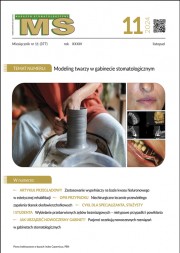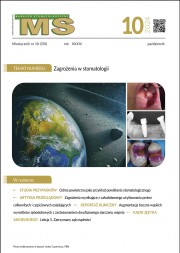Dostęp do tego artykułu jest płatny.
Zapraszamy do zakupu!
Po dokonaniu zakupu artykuł w postaci pliku PDF prześlemy bezpośrednio pod twój adres e-mail.
ARTYKUŁ PRZEGLĄDOWY
Wybrane aspekty farmakoterapii w stomatologii dziecięcej – przegląd piśmiennictwa
Selected aspects of pharmacotherapy in pediatric dentistry – a review of the literature
Alicja Wiśniewska, Iwona Wysoczańska-Jankowicz, Anna Dybek, Daria Pietraszewska, Danuta Ilczuk-Rypuła
Streszczenie
Farmakoterapia w stomatologii dziecięcej stanowi uzupełnienie leczenia miejscowego. Dziecko jest szczególnym pacjentem, u którego zarówno dawkowanie, jak i rodzaj zastosowanego leku powinny być dostosowane do odmiennego metabolizmu, możliwego działania niepożądanego w tej grupie wiekowej oraz trudności związanych z podaniem leku w określonej formie. Celem pracy jest omówienie możliwości leczenia farmakologicznego dzieci z zastosowaniem antybiotyków, leków przeciwbólowych oraz preparatów odkażających i wspomagających gojenie w praktyce lekarza dentysty.
Abstract
Pharmacotherapy in pediatric dentistry complements local treatment. Children are unique patients, requiring dosage and drug selection to be tailored to their different metabolism, potential side effects specific to this age group, and challenges associated with administering medication in certain forms. This paper aims to discuss the possibilities of pharmacological treatment in children, focusing on the use of antibiotics, analgesics, and disinfectants, as well as healing-supporting agents in dental practice.
Hasła indeksowe: dziecko, farmakoterapia, stomatologia dziecięca, leki
Key words: child, pharmacotherapy, pediatric dentistry, medicaments
Piśmiennictwo
-
Ready D, Bedi R, Spratt DA i wsp. Prevalence, proportions, and identities of antibiotic-resistant bacteria in the oral microflora of healthy children. Microb Drug Resist. 2003; 9(4): 367-372.
-
Nemoto H, Nomura R, Ooshima T i wsp. Distribution of amoxicillin-resistant oral streptococci in dental plaque specimens obtained from Japanese children and adolescents at risk for infective endocarditis. J Cardiol. 2013; 62(5): 296-300.
-
Palmer NO, Martin MV, Pealing R i wsp. Paediatric antibiotic prescribing by general dental practitioners in England. Int J Paediatr Dent. 2001; 11(4): 242-248.
-
Droste JH, Wieringa MH, Weyler JJ i wsp. Does the use of antibiotics in early childhood increase the risk of asthma and allergic disease? Clin Exp Allergy. 2000; 30(11): 1547-1553.
-
Yallapragada SG, Nash CB, Robinson DT. Early-life exposure to antibiotics, alterations in the intestinal microbiome, and risk of metabolic disease in children and adults. Pediatr Ann. 2015; 44(11): e265-e269.
-
Hong L, Levy SM, Warren JJ i wsp. Association of amoxicillin use during early childhood with developmental tooth enamel defects. Arch Pediatr Adolesc Med. 2005; 159(10): 943-948.
-
“American Academy of Pediatric Dentistry. Useful Medications for Oral Conditions”. Chicago, III: American Academy of Pediatric Dentistry; 2019.
-
Goel D, Goel GK, Chaudhary S i wsp. Antibiotic prescriptions in pediatric dentistry. A review. J Family Med Prim Care. 2020; 9(2): 473-480.
-
Olczak-Kowalczyk D, Karolak-Żak D, Tymińska D i wsp. Antybiotyki w stomatologii dziecięcej. Nowa Stomatol. 2014; 3: 131-137.
-
Alaluusua S, Veerkamp J, Declerck D. Policy document for the use of antibiotics in paediatric dentistry. 2002.
-
Muppa R, Nallanchakrava S, Chinta M i wsp. Nonsyndromic localized aggressive periodontitis of primary dentition. A rare case report. Contemp Clin Dent. 2016; 7(2): 262-264.
-
Kaczmarzyk T, Babiuch K, Bołtacz-Rzepkowska E. i wsp. Rekomendacje Grupy Roboczej Polskiego Towarzystwa Stomatologicznego i Narodowego Programu Ochrony Antybiotyków w zakresie stosowania antybiotyków w stomatologii. Warszawa; 2019: 17-18.
-
Slots J, Rams TE. Antibiotics in periodontal therapy. Advantages and disadvantages. J Clin Periodontol. 1990; 17(7): 479-493.
-
Prakasam A, Elavarasu SS, Natarajan RK. Antibiotics in the management of aggressive periodontitis. J Pharm Bioallied Sci. 2012; 4(suppl 2): S252-S255.
-
Hammami C, Nasri W. Antibiotics in the treatment of periodontitis. A systematic review of the literature. Int J Dent. 2021; 2021: 6846074.
-
Council on Clinical Affairs of American Academy of Pediatric Dentistry. Guideline on use of antibiotic therapy for pediatric dental patients. 2009.
-
Dzierżanowska D, Dzierżanowska-Fangrat K. Przewodnik antybiotykoterapii. Wyd. 25. Bielsko-Biała: Alfa-Medica Press; 2020: 16-17.
-
Palmer GM. Pain management in the acute care setting. Update and debates. J Paediatr Child Health. 2016; 52(2): 213-220.
-
Segura-Egea JJ, Gould K, Şen BH i wsp. Antibiotics in endodontics. A review. Int Endod J. 2017; 50(12): 1169-1184.
-
Cherry WR, Lee JY, Shugars DA i wsp. Antibiotic use for treating dental infections in children. A survey of dentists’ prescribing practices. J Am Dent Assoc. 2012; 143(1): 31-38.
-
Daly CG. Antibiotic prophylaxis for dental procedures. Aust Prescr. 2017; 40(5): 184-188.
-
Esposito S, Castellazzi L, Tagliabue C i wsp. Allergy to antibiotics in children. An overestimated problem. Int J Antimicrob Agents. 2016; 48(4): 361-366.
-
Dar-Odeh N, Fadel HT, Abu-Hammad S i wsp. Antibiotic prescribing for oro-facial infections in the paediatric outpatient. A review. Antibiotics (Basel). 2018; 7(2): 38.
-
Diangelis AJ, Andreasen JO, Ebeleseder KA i wsp. International Association of Dental Traumatology guidelines for the management of traumatic dental injuries: 1. Fractures and luxations of permanent teeth. Dent Traumatol. 2012; 28(1): 2-12.
-
Andreasen JO, Jensen SS, Sae-Lim V. The role of antibiotics in preventing healing complications after traumatic dental injuries. A literature review. Endod Topics. 2006; 14(1): 80-92.
-
Schwartz S. DDS. Commonly prescribed medications in Pediatric Dentistry Crest® Oral-B® at dentalcare.com Continuing Education Course. Revised January 8, 2016.
-
Inchara R, Ganapathy D, Kiran Kumar P. Preference of antibiotics in pediatric dentistry. Drug Inv Tod. 2019; 11(6): 1495-1498.
-
Ziółkowska L. Profilaktyka infekcyjnego zapalenia wsierdzia w świetle nowych wytycznych. Pediatria po Dyplomie. 2016; 2.
-
Piekoszewska-Ziętek P, Turska-Szybka A, Olczak-Kowalczyk D. Infekcje zębopochodne – przegląd piśmiennictwa. Nowa Stomatol. 2016; 21(2): 120-134.
-
Cope AL, Francis N, Wood F i wsp. Systemic antibiotics for symptomatic apical periodontitis and acute apical abscess in adults. Cochrane Database Syst Rev. 2018; 9(9): CD010136.
-
Kocot-Kępska M, Szułdrzyński K. Skale oceny bólu. Medycyna Praktyczna. 2014; 5.
-
Kanabar DJ. A clinical and safety review of paracetamol and ibuprofen in children. Inflammopharmacology. 2017; 25(1): 1-9.
-
Bjarnason I. Gastrointestinal safety of NSAIDs and over-the-counter analgesics. Int J Clin Pract Suppl. 2013; 178: 37-42.
-
Graham GG, Davies MJ, Day RO i wsp. The modern pharmacology of paracetamol. Therapeutic actions, mechanism of action, metabolism, toxicity and recent pharmacological findings. Inflammopharmacology. 2013; 21(3): 201-232.
-
Wong I, St John-Green C, Walker SM. Opioid-sparing effects of perioperative paracetamol and nonsteroidal anti-inflammatory drugs (NSAIDs) in children. Paediatr Anaesth. 2013; 23(6): 475-495.
-
Barbagallo M, Sacerdote P. Ibuprofen in the treatment of children’s inflammatory pain. A clinical and pharmacological overview. Minerva Pediatr. 2019; 71(1): 82-99.
-
Świątkowska-Bury M, Olczak-Kowalczyk D. Pacjent z astmą oskrzelową w gabinecie stomatologicznym – przegląd piśmiennictwa dotyczącego postępowania leczniczego. Nowa Stomatol. 2020; 25: 41-49.
-
Grzanka A, Wasilewska I, Śliwczyńska M i wsp. Hypersensitivity to local anaesthetics. Anaesthesiol Intensive Ther. 2016; 48(2): 128-134.
-
Kurmis AP, Kurmis TP, O’Brien JX i wsp. The effect of nonsteroidal anti-inflammatory drug administration on acute phase fracture-healing. A review. J Bone Joint Surg Am. 2012; 94(9): 815-823.
-
Szymański M, Korzeniowska K, Jabłecka A. Nerkowe działania niepożądane związane ze stosowaniem NLPZ. Geriatria. 2014; 8: 1-9.
-
Southey ER, Soares-Weiser K, Kleijnen J. Systematic review and meta-analysis of the clinical safety and tolerability of ibuprofen compared with paracetamol in paediatric pain and fever. Curr Med Res Opin. 2009; 25(9): 2207-2222.
-
Hersh EV, Moore PA, Grosser T i wsp. Nonsteroidal anti-inflammatory drugs and opioids in postsurgical dental pain. J Dent Res. 2020; 99(7): 777-786.
-
Malicka B, Ziętek M, Grzebieluch W. Zastosowanie chlorheksydyny w stomatologii. Dent Med Probl. 2005; 42(3): 497-505.
-
Bescos R, Ashworth A, Cutler C i wsp. Effects of chlorhexidine mouthwash on the oral microbiome. Sci Rep. 2020; 10(1): 5254.
-
Eick S, Goltz S, Nietzsche S i wsp. Efficacy of chlorhexidine digluconate-containing formulations and other mouthrinses against periodontopathogenic microorganisms. Quintessence Int. 2011; 42(8): 687-700.
-
Montiel-Company JM, Almerich-Silla JM. Efficacy of two antiplaque and antigingivitis treatments in a group of young mentally retarded patients. Med Oral. 2002; 7(2): 136-143.
-
Barkvoll P, Rølla G, Svendsen AK. Interaction between chlorhexidine digluconate and sodium lauryl sulfate in vivo. J Clin Periodontol. 1989; 16(9): 593-595.
-
Segura-Egea JJ, Gould K, Şen BH i wsp. Antibiotics in endodontics. A review. Int Endod J. 2017; 50(12): 1169-1184.
-
Grover V, Mahendra J, Gopalakrishnan D i wsp. Effect of octenidine mouthwash on plaque, gingivitis, and oral microbial growth. A systematic review. Clin Exp Dent Res. 2021; 7(4): 450-464.
-
Polskie Towarzystwo Leczenia Ran. Stanowisko Polskiego Towarzystwa Leczenia Ran dotyczące bezpieczeństwa stosowania produktu leczniczego Octenisept®. Warszawa; 2019.
-
Kowalski J. Zastosowanie jodopowidonu (powidonku jodyny) w praktyce periodontologicznej – zalety i ograniczenia działania. Mag Stomatol. 2016; 6: 52-55.
-
Hosaka Y, Saito A, Maeda R i wsp. Antibacterial activity of povidone-iodine against an artificial biofilm of Porphyromonas gingivalis and Fusobacterium nucleatum. Arch Oral Biol. 2012; 57(4): 364-368.
-
Montevecchi M, Dorigo A, Cricca M i wsp. Comparison of the antibacterial activity of an ozonated oil with chlorhexidine digluconate and povidone-iodine. A disk diffusion test. New Microbiol. 2013; 36(3): 289-302.
-
Wrzyszcz-Kowalczyk A, Kaczmarek U, Pregiel B i wsp. Zastosowanie preparatu Povidone-Iodine w optymalizacji leczenia próchnicy wczesnej. Czas Stomatol. 2008; 61(11): 757-766.














